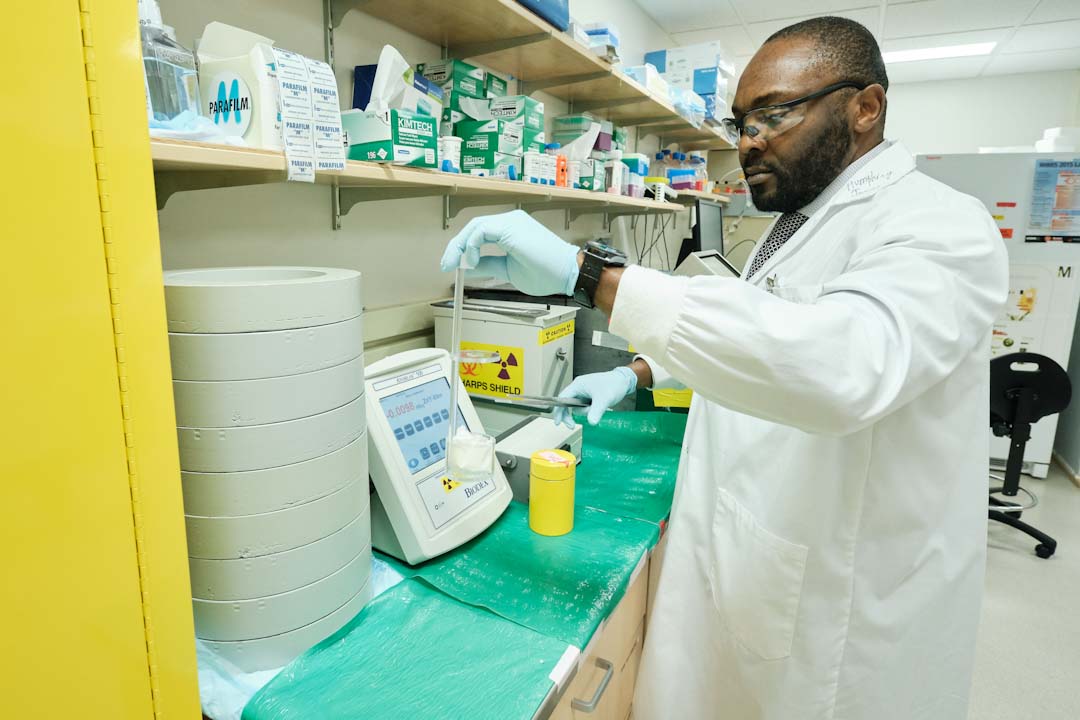
USask researcher targets aggressive breast cancers with new drugs
More than 5,100 women in Canada—about 75 a day—will die from breast cancers this year, a dismal statistic that University of Saskatchewan (USask) radiopharmacist Dr. Humphrey Fonge (PhD) aims to sharply reduce with potent new drugs that specifically target two aggressive types of cancer.
By USask Research Profile and ImpactWith $970,000 from the Canadian Institutes for Health Research, Fonge and co-applicant Dr. Ron Geyer (PhD), a professor in pathology and laboratory medicine at USask, will develop new molecules to attack two protein molecules that cause these types of breast cancer.
“Along with precision therapeutics that will attack these proteins from several angles, we are also developing radioactive imaging molecules for use in conjunction with a PET (positron emission tomography) camera to locate the sites and activity of these cancers,” said Fonge, associate professor in medical imaging at USask’s College of Medicine.
“We anticipate that these strategies will be more effective than current treatment approaches in more than 50 per cent of all breast cancers,” he said, noting that preliminary data show promising outcomes.
Fonge will be conducting some of his research at the university’s Saskatchewan Centre for Cyclotron Sciences managed by the Fedoruk Centre at USask. Geyer, Nutrien Chair in Clinical Research, will produce an antibody molecule for the project at his lab, which is funded through his chair and involves the medical college, Saskatchewan Health Authority, Royal University Hospital (RUH), and the RUH Foundation.
Tackling two types of cancer
The first research target is triple negative breast cancer (TNBC), a highly aggressive form that mostly affects women under age 50 and makes up 15 to 20 per cent of all breast cancers. The protein molecule, Epidermal Growth Factor Receptor 1 (EGFR), is overexpressed (10-fold to 1,000-fold more than in healthy breast tissue) on the surface of a vast majority of TNBC tumours.
This EGFR-positive cancer is difficult to treat because there’s no effective drug treatment for it. Patients are given chemotherapy or radiation treatment, but usually move on to palliative care if the treatments fail, Fonge said.
The second type of targeted cancer involves the protein Human Epidermal Growth Factor Receptor 2 (HER2) that’s overexpressed on the surface of tumours. HER2-positive cancers make up about one-quarter to one-third of all breast cancers.
Although some precision therapeutics are approved for treating these cancers, a majority of patients (about 70 per cent) either don’t respond to the treatment or develop a resistance to the drugs, which can cost tens of thousands of dollars.
Prime targets for PET imaging, radiotherapy
The abundance of EGFR and HER2 molecules on the tumour surfaces make these proteins prime targets to locate through PET imaging and treat with radiolabelled antibodies, Fonge said.
Each of these cancer-causing proteins has four external spots (domains I-IV) to which an antibody molecule can bind. Every drug currently on the market attacks only the protein molecules at one of these spots, Fonge said.
His research is focused on developing new radioactive drug molecules that, for the first time, can simultaneously attack EGFR and HER2 from more than one domain. To do this, he is using the antibody molecule 8709, which has been patented by Geyer. Fonge is also modifying three drugs currently on the market to make them more potent.
The new drugs will be domain-specific, attaching to domains II and IV on the HER2 molecule, and domains II and III on the EGFR molecule. They will both deliver the potent cytotoxic molecules to kill the cancer cells. This strategy is more potent and effective than current approaches, Fonge said.
The new drugs first will be tested in vitro on cancer cells obtained from patients, and then on mice.
Although the study is approved for five years, Fonge is optimistic he will have enough “powerful data” after three years to proceed to an initial clinical trial of the treatments.
“The ideal scenario is that once the study is done, we will have four tools in our pocket that target two different breast cancers. For both types, we are going to have a diagnostic solution and a therapeutic solution,” he said.

